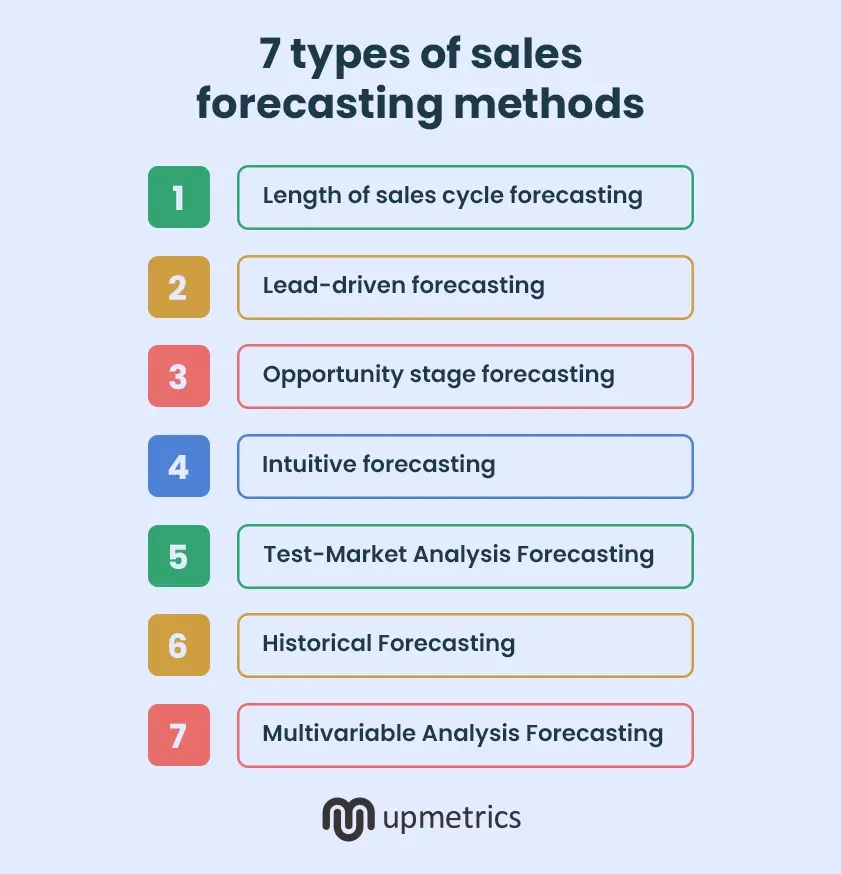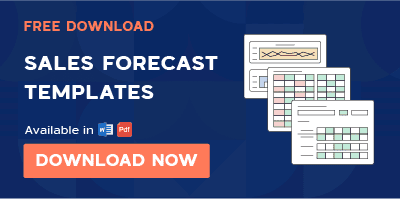Every business has to prepare for the future and one of the most crucial aspects of this preparation is creating accurate sales forecasts.
Sales forecasting is at the core of efficient resource allocation, supply chain management, cash flow management, and business growth into new markets.
Its importance cannot be overstated. However, when it comes to preparing sales forecasts, most entrepreneurs struggle.
Well, let’s help you out. In this blog post, we’ll guide you through various sales forecasting methods and explain how to create reliable forecasts. We also have some examples for you to get a better overview.
Let’s get started. But before that..
What is sales forecasting?
Sales forecasting is estimating the future sales volume for your company over a given period. An accurate sales forecast helps manage cash flow, optimize resource allocation, and support strategic planning for future growth.
Sales projections typically rely on historical sales data, industry-wide benchmarks, and current economic trends. Accurate sales forecasting depends on two factors: having the appropriate data and making informed, logical inferences from that data. It is much easier to make a sales prediction when you have access to reliable data.
Now, before we go ahead and discuss the methods of sales forecasting, why exactly is it essential to create sales forecasts? Let’s understand in the next section.
→ Download Now: Free Sales Forecast Template
Importance of sales forecasting
Sales forecasting plays a vital role in helping businesses manage their budgets, ensuring they have enough resources to invest in new products and services.
Here are a few reasons why sales forecasting is important:
- Helps businesses manage budgets and plan investments.
- Boosts credibility with investors and stakeholders.
- Provides operational confidence by predicting future cash flow.
- Identifies potential issues like lead shortages early.
- Assists in hiring and inventory management decisions.
- Informs strategic decisions such as product launches and market expansions.
Mitigates risks by preparing for market fluctuations.
7 types of sales forecasting methods
Now, methods to forecast sales vary depending on factors such as the data being used, the time frame of the forecast, and the specific business objectives. While some techniques focus on historical sales, others take into account market trends and sales pipeline stages to calculate forecasts.
Let’s check these 7 forecasting methods:

1. Length of sales cycle forecasting
The forecasting approach uses data on how long it takes a prospective customer to convert into a paying customer.
This form of forecasting is objective because it does not rely on the emotions of your sales staff. It is ideal for businesses to track when new customers will enter their sales pipeline and when the deal will close.
2. Lead-driven forecasting
This algorithm analyzes previous sales data from each lead source to predict the future.
To use this approach, you’ll need measurements such as leads per month for the preceding month and the average sales price which may vary depending on the source. To calculate the total number of leads required in a given period, divide the total expected sales by the average lead value.
The average sales cycle may vary depending on the lead source and other business efforts may pact your conversion rates. Adjust your marketing strategies as new trends and data emerge to ensure your lead volume and conversion rates align with predictions.
3. Opportunity stage forecasting
This model predicts the likelihood of an opportunity closing based on where the prospect is in your sales process. In this technique, you anticipate future sales by multiplying the amount of each opportunity by the probability of it closing at its current stage.
This method needs a CRM system that automatically assigns win probability for each stage, essential for an accurate forecast.
4. Intuitive forecasting
The intuitive forecasting method relies on the judgment of your sales team based on their interactions and opinions about whether a sale will close.
Your salesman is the ideal person to offer this insight. However, if the sales representatives are optimistic, they may make exaggerated predictions, and there is no way to evaluate the statistics.
5. Test-Market Analysis Forecasting
The forecasting method of Test-Market Analysis allows you to roll out your product or service to a specific set of people depending on their demands. You can use the rollout findings to produce a more accurate future market projection.
6. Historical Forecasting
Historical forecasting relies on past sales data to predict future performance but does not account for dynamic market developments. For example, if your competitors executed a promotional campaign, it could result in a drop in sales. Using this strategy, you anticipate the MRR based on historical trends, such as assuming a 10% annual growth rate.
7. Multivariable Analysis Forecasting
Multivariable analysis forecasting is a fantastic choice if you want the most accurate forecasting method. It considers elements from different sales forecasting methodologies such as opportunity stage forecasting and individual rep performance to create a comprehensive forecast.
However, as it involves complexity and advanced calculations, this strategy may be impractical for small enterprises.
These are a few of the many sales forecasting methods used by small businesses, corporations, and enterprises to predict their sales. Let’s now help you choose the right sales forecasting method for your business.
How to choose the right sales forecasting method
It’s important you choose the right forecasting method that can help you achieve your strategic goals.
Follow this simple step-by-step guide:
1. Establish an objective
What do you want to achieve with your sales forecast? Do you want to use it to plan your inventory or to dictate your marketing efforts?
Setting a clear objective helps you choose a forecasting method more suited to reach there. At this stage, also clarify your sales goal. Instead of a vague figure, be very precise about how you want your sales to perform.
2. Consider the data availability
Established businesses can rely on historical data to build their projections. However, it’s important to assess the quality and availability of extensive to ensure it’s beneficial for your business.
Quantitative methods of forecasting are suited for businesses that have an extensive collection of previous data. However, newly emerging businesses must choose qualitative methods to make up for the lack of data.
3. Complexity of the sales cycle
Evaluate the complexity of your sales cycle. Businesses with pretty straightforward sales cycles can easily do with simpler forecasting methods like length of sales or opportunity sales. However, if yours is a complex sales cycle, you may require multivariable analysis forecasting.
4. Evaluate your resources
Assess the two important resources before finalizing your forecasting method: Time and budget. Different forecasting methods take different times depending on the availability of data.
Establish the importance of forecast predictions for your business and dedicate a budget and time frame. Then evaluate different forecasting methods to see what suits your business.
Once you finalize your forecasting method, acquire essential tools and technologies that can help you streamline the process.
Sales Forecasting Examples
Let’s now solidify our understanding of sales forecasting with these practical examples.
1. Using Current Funnel
Assume you have three opportunities this month: One is a brief phone call with an expected value of $2,000. Another opportunity worth $3,000 can be received through a thorough demo. Lastly, there’s an offer with a $2,400 estimated value.
Phone Call marks a 30% likelihood of closure. Demo may close at a 40% possibility while Offer has a 70% likelihood of closing.
To get a total sales prediction, you multiply the probabilities by the predicted value of the contract and add them all up to get $ 3,480, as shown in the following example:
2. Using Lead Scores and Multiple Variables
You can forecast your sales using lead scores and multiple variables. Use average opportunity sizes to calculate the anticipated value of any specific chance:
Divide your leads into three groups based on their qualities: A, B, and C. These variables influence the chance of a closing deal.
For instance, organizations with 50 or fewer employees may have a lower closing rate, whereas companies with employees more than that have more probability of closing the deal.
By categorizing your leads this way, you can make more accurate sales predictions.
3. Using Historical Data
Assume you had $300,000 in revenue last month and that your sales revenue has risen at a rate of 12% per month over the previous year. Your monthly churn was approximately 1%.
Your projected revenue for the following month will be:
($300,000 * 1.12) – ($300,000 * .01) = $333,000
It is derived by multiplying the past month’s income by the projected growth, and from the resultant amount, you need to deduct the churn.
Factors Influencing Sales Forecasting
Sales forecasting is shaped by a range of external and internal factors that can significantly alter projections. Understanding these factors is essential to ensure your forecasts are accurate and adaptable to changing conditions.
1. Economic conditions
Economic conditions affect every firm and market. When the economy is in a slump, people/businesses lose money and are less likely to buy, whereas people are more likely to invest and buy when the economy is booming.
2. Policy changes
Policy changes or implementing new laws/regulations can benefit or hinder your firm. You must consider these when forecasting your sales for the coming month.
3.Product changes
Any updates or modifications to your product, such as a redesign or added features, can significantly influence sales. Product improvements can boost demand, while unforeseen issues with new features might slow it down.
4. Technological changes and competition
Factors such as new technology advancements, design, competitors running promotional offers, or new businesses entering the fray might modify and affect the industry’s market share – which will factor into your sales estimates.
That said, try factoring in different scenarios early on to reduce the negative impacts of external factors on your business.
Build your financial forecasts with Upmetrics
Sales forecasting is extremely important for businesses to set realistic targets and make informed strategic decisions.
By choosing the right forecasting method, businesses can gain a clearer picture of their future sales performance.
Now, there are challenges when it comes to preparing your sales forecasts. However, with the Upmetrics business planning app, you get guided workflow, AI assistance, and ready-to-use templates that help you plan for different scenarios for up to 7 years. It’s easy to use and integrates with popular accounting systems like Xero and Quickbooks.

